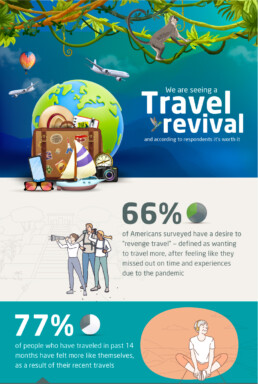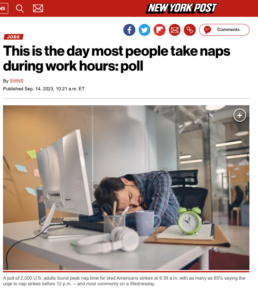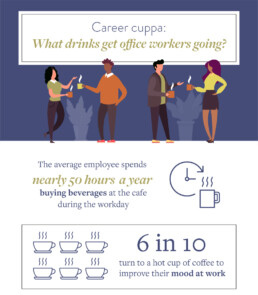There are many, many different types of survey questions you can employ — but there are some common ones we see (and recommend!) again and again within our custom research and PR surveys.
Here are the seven types of questions we use most often, along with our recommendations for when to utilize them to get the best data…
1) Yes/no questions
These are great for simple, straightforward questions — for example,
“Have you traveled internationally in the past year?”
Respondents either have traveled internationally or they haven’t (there’s no middle ground), and the specific timeframe means we likely don’t need a “not sure” or “can’t remember” option.
We caution against too many “yes/no” questions within a survey because there is limited data you can gather with them, but they can be great for those straightforward questions!
2) Five-point Likert scales
We often see these confused with “yes/no” questions — they’re similar, but they aren’t interchangeable. As mentioned, “yes/no” questions are used for factual statements; the Likert scale, on the other hand, should be used when an opinion is being asked.
The most common scale we use is “agree/disagree” (strongly agree, somewhat agree, neither agree nor disagree, somewhat disagree and strongly disagree), but there are various other scales you can use instead. One thing to keep in mind though, is ensuring the question is balanced — both in the phrasing, and ensuring you have a neutral middle option (in this case, “neither agree nor disagree”).
3) Single-select and multiple-choice lists
Personally, lists are one of my favorite survey questions — used correctly, you can get a ton of great information from a list.
For example, we ran a survey for Herbalife which revealed who Americans believe to be the most influential entrepreneur (Bill Gates came out on top). To get that information, we gave respondents a list of over 40 entrepreneurs from the past 50 years. This list was then used to create the top of our news copy.
There are a few different things to consider with lists:
First, how many options respondents should be allowed to select. We often do “please select all that apply,” but there are times that asking them to select five, three or just one option is best — it depends partially on how many options are included in the list, as well as what the question is asking (are you looking for the top or the favorite?).
Second, the length of the list should also be considered: if you have a list like Herbalife, in which each option is short and the list as a whole needs to be inclusive, including a lot of options is fine. But if the options are all long, like phrases or short sentences, that’s a lot more for respondents to read — and the list as a whole should include fewer options to account for that.
A specific type of list we like to employ is numerical, giving respondents a list of numbers or times and asking them to select one.
We used this method in a research-led story for vitamin and supplements brand Nature’s Bounty, pinpointing “peak nap time.” The data revealed that 9:39 a.m. is the peak time for napping — and that the urge to nap strikes before midday for 65% of Americans.
This can work well not only to find an average time, but also an average number.
For example, the number of times the average couple argues in a week, the average number of minutes wasted in meetings at work and even the average time spent buying coffee or other beverages during a workday.
4) Grid questions
Grid questions are another type of question that we often see being misused — people sometimes see them as an easy way to ask multiple questions within one, combining unrelated options to get the most data from one single question. Not only is that the wrong way to use grid questions, but it can be actively harmful to the survey — it dilutes the question, and can more quickly cause respondent fatigue.
Instead, grid questions should be employed sparingly within surveys, and you need to ensure the options being provided are not only related, but that they all use the same scale.
For example, let’s take the question:
“When traveling, how much money are you planning to spend on the following?”
Your grid would then have various dollar amounts on one column, and activities or travel-related spends on the other. You might ask respondents how much they’re planning to spend on meals each day, or activities each day — but you wouldn’t want to include the cost of roundtrip plane tickets within that same grid.
Even though all the options are related to travel, we can assume that plane tickets will be much more expensive than daily meals, and it would greatly change the scale. It would be better to separate that into two questions, so the scale is most relevant for the options included.
We also recommend limiting the number of options included within a grid: even if they’re all related, and all use the same scale, seeing a wall of text can be overwhelming for respondents. Breaking them up into smaller, more focused questions is a much better way to go.
5) Free text questions
Free text questions, also commonly referred to as “open-ended questions” are absolutely wonderful — when employed correctly. With these, you can gather respondents’ direct thoughts on a question or a topic. They can provide some really useful, unique insights . . . but employed wrong, and you’re left wasting respondents’ time, and your own, as you read through the responses.
Our tips?
Use free text questions sparingly, and put them in the first half of the survey (unless it’s necessary to put them later, due to the flow or routing). Limiting the number of free text questions will encourage respondents to spend time on the ones you do include — and putting them earlier in the survey helps to avoid respondent fatigue; if they’re the last questions, respondents may be more willing to skip the question, just to get to the end.
We’d also recommend thinking about routing within the survey. Thinking again about a survey of travelers, instead of immediately asking them to share a “travel nightmare” they’ve experienced, we’d first want to ask if they’ve ever had a “travel nightmare.” Only those who say “yes” would be asked the free text question — this ensures a higher quality of response, though there would be fewer people seeing the question.
6) Photo questions
There’s a couple of options when it comes to photo questions:
First, including photos within a survey. This can be great for knowledge tests.
We ran a survey for Avocado Green Mattress which asked respondents to identify different photos of plants and trees to test how much they know about nature. It’s a fun, easy way to gather some unique data (and help keep respondents engaged in a survey!).
Second, you can also ask respondents to share photos to go along with the data after responses are gathered. For example, if you’re running a survey for Halloween, looking at how many people have dressed their pet up for the holiday — what’s cuter than asking people to submit photos of their pets wearing their Halloween costumes? You can’t expect everyone to participate, but even five or 10 quality photos would add a great visual element to a report or article highlighting the data.
7) Slider scales
Last but not least, we have “slider scales.” These can work for a few different types of questions, but we find success when asking for a breakdown of percentages that will all add up to 100 (breaking down how they spend their time at work, for example). The slider gives them a maximum, which can help with quality checking, as we’re then not asking individual respondents to do the math required to ensure their answers all add up to 100%.
Additionally, I’d be remiss to not mention demographic and screener questions.
These are special kinds of questions, and they’re both used at the start of the survey.
Demographic questions will gather basic information about our respondents: for example, their age, gender and the region in which they live. Typically, we then use these demographic questions as “splits” within the data, allowing us to compare respondents by their answers (looking at men vs. women, millennials vs. baby boomers, etc.) — it’s a great way to see trends within the data and look at the responses in a slightly deeper way.
Screener questions are used to “screen” respondents out of the survey. For example, if we’re running a survey of cat and dog owners, we’d include two screener questions: the first would ask respondents what they own (for example, a pet, a car, a computer, a house, etc.). Then, for those who selected “pet,” they’d see a list of pets: within that question, they’d need to select cat and/or dog to enter the survey — otherwise, they’d be screened out, because they don’t fit the demographic required.Screeners ensure we’re reaching the sample for our survey, allowing us to gather the best data. These are often multi-select list questions, but that’s not always the case — it can vary based on which demographic we’re trying to reach.
In conclusion, regardless of what data you’re collecting, it’s incredibly important you’re using the correct types of survey questions. That ensures you’re gathering the best possible data, and it allows the data to stand up to scrutiny from journalists, or from other people interacting with your findings. Not only that, but varying the types of questions you’re using within the survey will help keep respondents engaged — providing better, higher-quality answers.
OnePoll has been conducting custom research and PR surveys for 20 years. We provide custom research services to brands, agencies and the media. As members of AAPOR — the American Association for Public Opinion Research, OnePoll researchers adhere to the principles and actions set out in the AAPOR Code. Our research team are also members of ESOMAR and MRS. Like to know more? Talk to our team or request a rate card.
Featured image photo credit: Jason Leung







